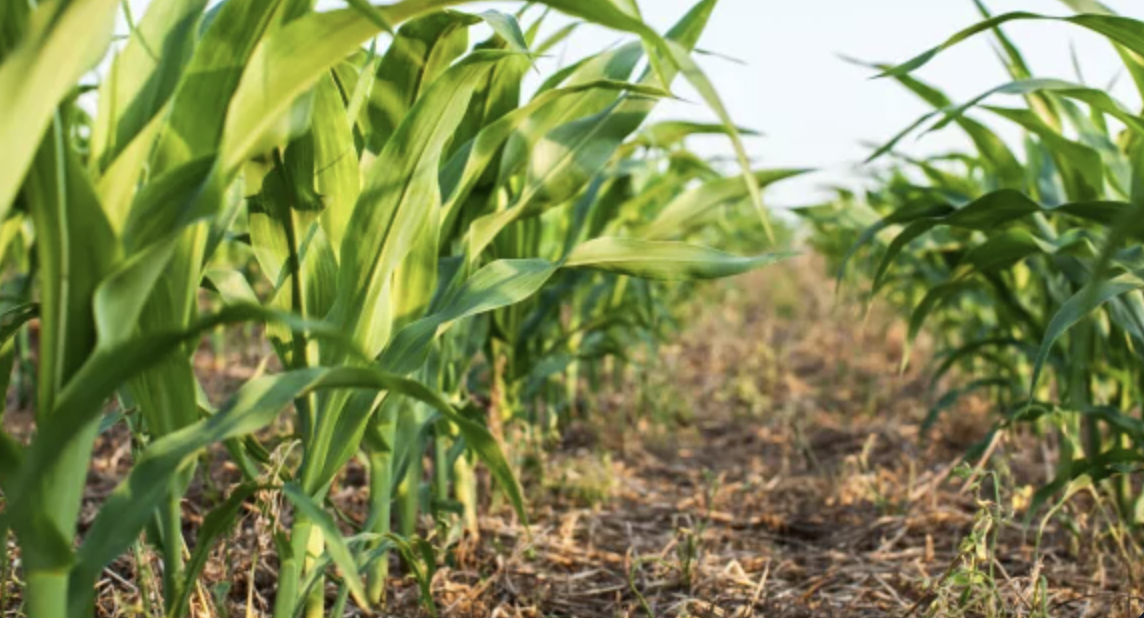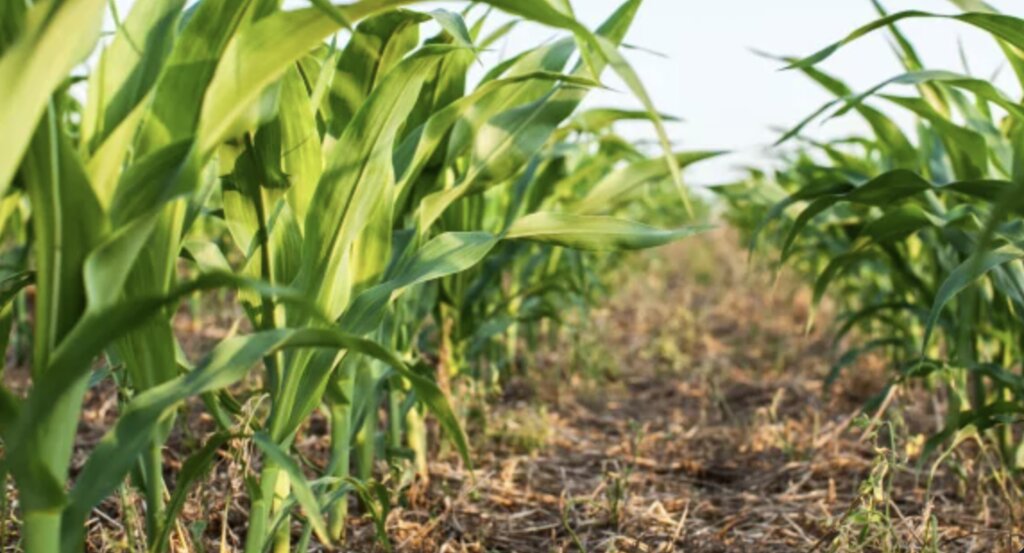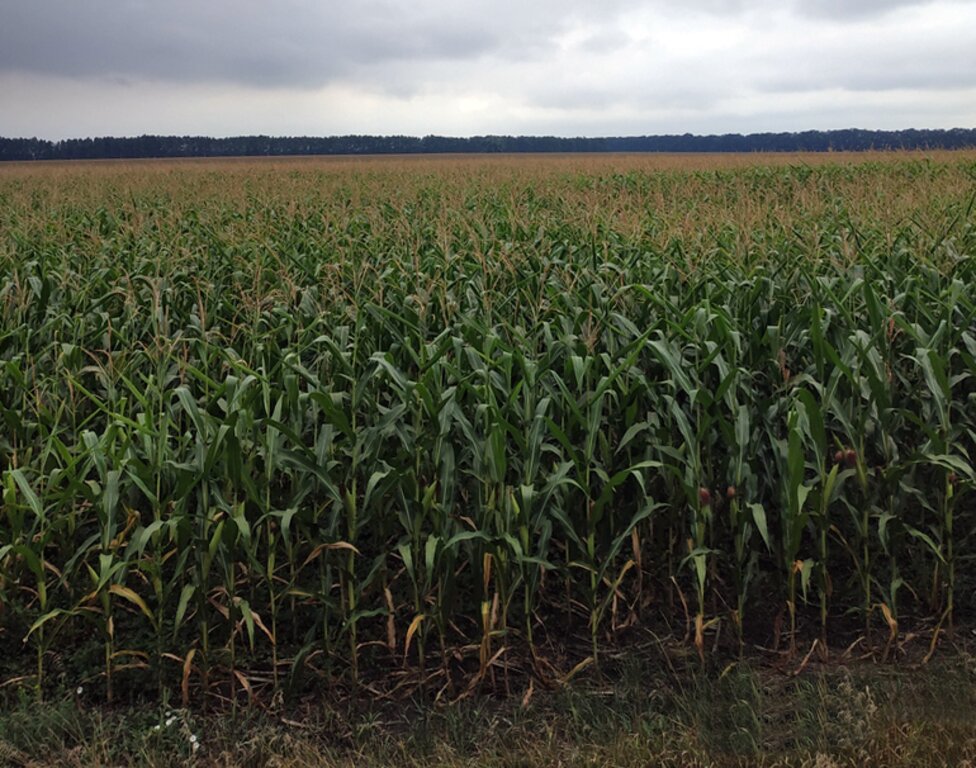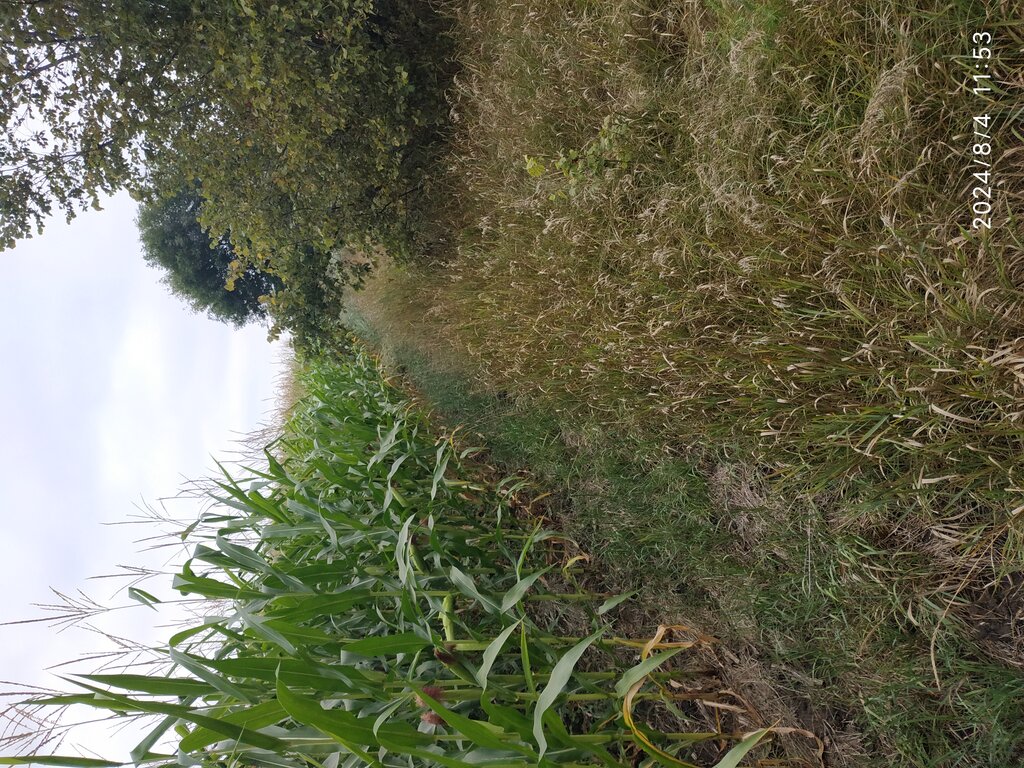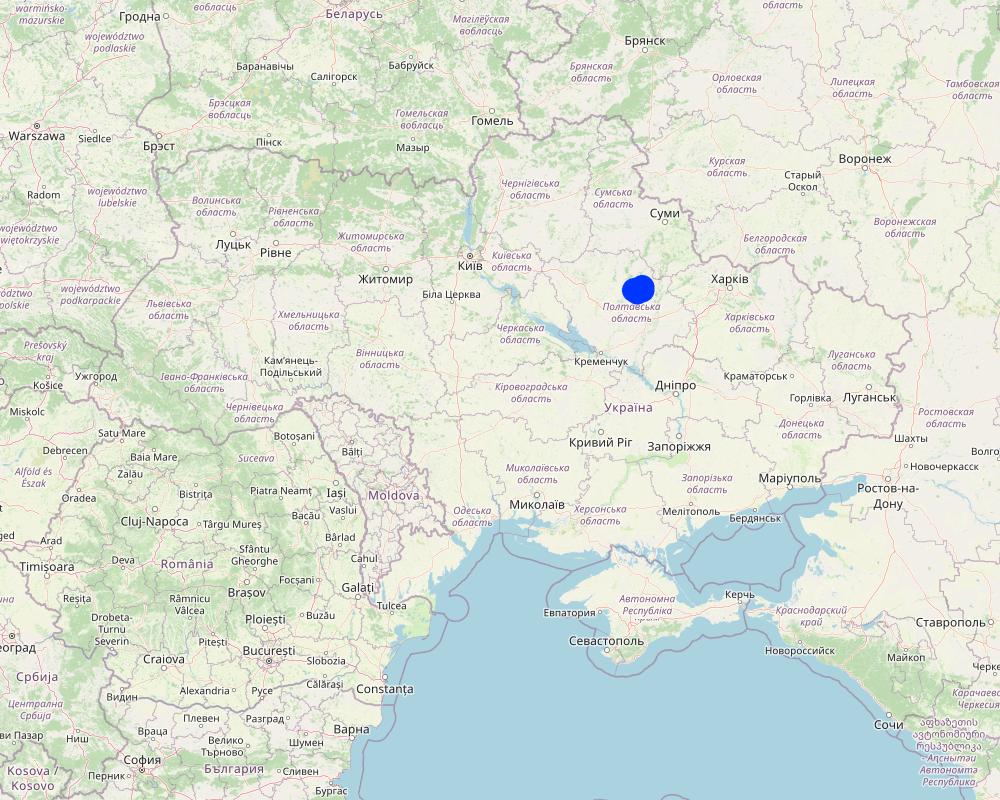Organic Agriculture with Reduced Tillage [أوكرانيا]
- تاريخ الإنشاء:
- تحديث:
- جامع المعلومات: Natalia Prozorova
- المحرر: –
- المراجعون: William Critchley, Rima Mekdaschi Studer
Organic Agriculture
technologies_7440 - أوكرانيا
عرض الأقسام
توسيع الكل طي الكل1. معلومات عامة
1.2 تفاصيل الاتصال بالأشخاص الرئيسيين لمصدر المعلومات والمؤسسات المشاركة في تقييم وتوثيق التقنية
الشخص (الأشخاص) الرئيسي لمصدر المعلومات
متخصص في الإدارة المستدامة للأراضي:
Prozorova Natalia
National Scientific Center «Institute for SoilScience and Agrochemistry Research, named after O.N. Sokolovsky»
أوكرانيا
اسم المشروع الذي سهّل توثيق/تقييم التقنية (إذا كان ذلك على صلة)
Land Use Based Mitigation for Resilient Climate Pathways (LANDMARC)اسم المؤسسة (المؤسسات) التي سهلت توثيق/تقييم التقنية (إذا كان ذلك على صلة)
Delft University of Technology (TU Delft)1.3 الشروط المتعلقة باستخدام البيانات الموثقة من خلال WOCAT
يوافق جامع المعلومات والشخص (لاشخاص) الرئيسي لمصدر المعلومات على الشروط المتعلقة باستخدام البيانات الموثقة من خلال WOCAT:
نعم
1.4 إعلان بشأن استدامة التقنية الموصوفة
هل التقنية الموصوفة هنا تمثل مشكلة فيما يتعلق بتدهور الأراضي، بحيث لا يمكن إعلانها تقنية مستدامة لإدارة الأراضي؟:
كلا
2. وصف تقنيةالإدارة المستدامي للأراضي
2.1 وصف مختصر للتقنية
تعريف التقنية:
This organic agriculture technology combines reduced tillage with organic farming practices to enhance soil health, increase carbon sequestration, and maintain sustainable agricultural productivity.
2.2 وصف تفصيلي للتقنية
الوصف:
This example of organic agriculture is applied primarily in the central Poltava region of Ukraine, which is characterized by undulating plains within the Poltava Plateau. The region’s fertile chernozem soils provide an ideal environment for sustainable farming practices. These soils are predominantly deep, medium-humus, medium-loam chernozems, known for their agronomically favourable physical and chemical properties, including high organic carbon content (around 3% in the upper layer) and excellent water retention capacity. The natural fertility of these soils, combined with their relatively high nitrogen and exchangeable potassium content, underpins their suitability for organic farming.
Organic agriculture in this context combines two land management technologies (LMTs): reduced tillage and organic farming. Reduced tillage minimizes soil disturbance, which preserves soil structure and reduces erosion, while organic farming eliminates synthetic inputs and relies on crop rotations, organic fertilizers, and biological pest control to maintain soil health and ecosystem balance. The purpose of these practices is to enhance soil carbon sequestration, mitigate climate change impacts, and support sustainable agricultural productivity.
Farming is certified as a producer of organic plant products in accordance with the standards equivalent to Council Resolutions (EU) 834/2007 and 889/2008.
Under this system, shallow tillage is carried out to a depth of 4–6 cm, which helps preserve the natural structure and capillarity of the soil. It employs Horsch cultivators of the "Agrosoyuz," "Scorpion," and "Quant" models. The enterprise also extensively uses disc harrows from the French manufacturer Grégoire Besson, such as the DXRV and DXRV-HD models, which are employed for green manure incorporation. These tools operate at a precisely determined depth, regardless of the micro-relief of the field. Thus, PE "Agroecology" does not use ploughs for inversion tillage but instead prioritizes shallow tillage with cultivators and disc harrows.
The main crops grown include winter wheat, soy, corn, sunflower, and perennial herbs such as sainfoin. The combination of these crops supports soil fertility and biodiversity while maintaining agricultural productivity. Land Mitigation Technology (LMT) refers to practices and technologies designed to reduce or offset the environmental impact of land use activities. It includes strategies for restoring degraded ecosystems, preventing soil erosion, conserving biodiversity, and managing resources sustainably. LMT is often applied in agriculture, construction, and land development to balance development needs with environmental protection.
Key activities to establish and maintain the technology include transitioning from conventional to organic farming practices, adapting tillage methods to reduced-intensity operations, and maintaining organic soil fertility through natural inputs. These activities require significant initial effort and investment, including soil testing for nutrient content and organic carbon stocks, stakeholder engagement for field planning, and long-term monitoring of soil health indicators. The establishment process also involves collaboration with scientific institutions, such as ISSAR and Bioclear Earth, to ensure effective implementation and validation of the technology.
The primary benefits of this technology include improved soil structure, increased biodiversity, reduced greenhouse gas emissions, and enhanced carbon sequestration. The technology has demonstrated the potential to sequester up to 0.4 t C ha⁻¹ yr⁻¹, with minimal yield trade-offs. Additionally, the resilience of the chernozem soils supports similar crop yields in both organic and conventional systems, thanks to their natural fertility and lower input rates in conventional agriculture. Farmers particularly value the long-term sustainability and ecological benefits of organic farming.
Land users face challenges with this technology. Transitioning to organic farming can result in temporary yield reductions, requiring adaptation in farm management practices. Furthermore, reduced tillage demands specific equipment and techniques, which may present a financial barrier for some farmers. The implementation of organic farming also requires significant effort in pest and weed management due to the absence of chemical inputs.
Overall, this form of organic agriculture represents a promising approach to sustainable farming in Ukraine, particularly in the fertile Chernozem region. Its ability to enhance carbon sequestration while maintaining comparable yields to conventional systems highlights its potential to contribute to climate mitigation and soil restoration goals. Further research and field validation are needed to refine the understanding of its impacts and optimize its implementation.
2.3 صور التقنية
ملاحظات عامة بخصوص الصور:
The photos provide a detailed view of the agricultural practices in the field, highlighting the healthy state of the maize crops in central Ukraine. These images capture the natural environment where organic farming techniques are being applied, showcasing the crops' growth, the quality of the soil, and the overall ecological balance. The close-up shots emphasize the care taken to maintain soil health and biodiversity, aligning with the principles of organic farming. The visuals also illustrate the sustainable land management practices that promote environmental stewardship and high agricultural yields.
2.5 البلد/المنطقة/المواقع التي تم تنفيذ التقنية فيها والتي يغطيها هذا التقييم
البلد:
أوكرانيا
المنطقة/الولاية/المحافظة:
Poltava region, Shishaky area
مزيد من التفاصيل حول الموقع:
Poltava region on the left bank of the river Psyol, in 20 km from urban-type settlement Shishaky and in 80 km to the regional center Poltava
حدد انتشار التقنية:
- منتشرة بالتساوي على مساحة
إذا كانت المساحة الدقيقة غير معروفة، فيرجى الإشارة إلى المنطقة التقريبية المغطاة:
- 10,000-1,000 كم2
هل يقع موقع/مواقع التقنية في منطقة محمية بشكل دائم؟:
كلا
Map
×2.6 تاريخ التنفيذ
في حالة عدم معرفة السنة بالتحديد، يرجى الإشارة إلى التاريخ التقريبي:
- منذ 10-50 سنة
2.7 إدخال التقنية
حدد كيف تم إدخال التقنية:
- من خلال ابتكار مستخدمي الأراضي
3. تصنيف تقنية الإدارة المستدامي للأراضي
3.1 الغرض الرئيسي ( الأغراض الرئيسية) للتقنية
- الحد من تدهور الأراضي ومنعه وعكسه
- التكيف مع تغير المناخ/الظواهر المتطرفة وآثارها
- التخفيف من تغير المناخ وآثاره
- chernozem productivity assessment between conventional and traditional agriculture
3.2 نوع (أنواع) استخدام الأراضي الحالية حيث يتم تطبيق التقنية
استخدامات الأراضي مختلطة ضمن نفس وحدة الأرض:
كلا

الأراضي الزراعية
- زراعة سنوية
- Perennial herbs
الزراعة السنوية - حدد المحاصيل:
- الحبوب - الحنطة السوداء
- الحبوب - قمح (شتوي)
نظام زراعة سنوي:
قمح أو دورة مماثلة مع القش/ زراعة المراعي
عدد مواسم الزراعة في السنة:
- 2
حدد:
Spring/Summer Season; Autumn/Winter Season
هل يتم ممارسة الزراعة البينية؟:
نعم
إذا كانت الإجابة بنعم، حدد المحاصيل التي يتم زراعتها بشكل بيني:
Intercropping involves a combination of perennial herbs (such as sainfoin) with annual crops like buckwheat or sunflower. This practice helps optimize resource use, improve soil fertility, and enhance field biodiversity.
هل تتم ممارسة تناوب المحاصيل؟:
نعم
إذا كانت الإجابة بنعم، حدد:
The crop rotation system includes a diverse mix of:
Annual crops: Buckwheat, winter wheat, soya, corn, and sunflower.
Perennial crops: Sainfoin, spelt, and other forage herbs.
This rotation is designed to Maintain soil fertility, Reduce the risk of pests and diseases, Optimize nutrient use, and Support sustainable farming practices. The rotation is adapted to the specific soil and climatic conditions of the region to ensure long-term productivity and environmental health.
3.3 هل تغير استخدام الأراضي نتيجة لتنفيذ التقنية؟
هل تغير استخدام الأراضي نتيجة لتنفيذ التقنية؟:
- لا (تابع مع السؤال 3.4)
3.4 إمدادات المياه
إمدادات المياه للأرض التي يتم تنفيذ التقنية عليها:
- بعلية
3.5 مجموعةالإدارة المستدامة للأراضي التي تنتمي إليها هذه التقنية
- تحسين الغطاء الأرضي/النباتي
- الإدارة المتكاملة لخصوبة التربة
3.6 التدابير التقنية في مجال إلادارة المستدامة للأراضي

التدابير الزراعية
- A1: الغطاء النباتي/التربة
- A2: المادة العضوية/خصوبة التربة
- A3: معالجة سطح التربة
3.7 الأنواع الرئيسية من تدهور الأراضي التي تناولتها التقنية

آخر
حدد:
Some water and wind erosion (but almost no erosion at all)
3.8 منع أو حد أو عكس تدهور الأراضي
تحديد هدف التقنية فيما يتعلق بتدهور الأراضي:
- منع تدهور الأراضي
التعليقات:
The organic agriculture system in Poltava prevents land degradation through sustainable practices, including:
Reduced tillage: Maintains soil structure and minimizes erosion.
Use of mulch: Organic mulch, such as crop residues, is applied to protect the soil from wind erosion, conserve moisture, and reduce surface runoff.
Crop rotation and intercropping: These practices improve soil health, reduce nutrient depletion, and promote biodiversity.
Green manure incorporation: Enhances soil organic matter and strengthens soil resilience against degradation.
This proactive approach ensures that the fertile chernozem soils remain productive and sustainable for future generations while reducing the risks of erosion and nutrient loss.
4. المواصفات الفنية، وأنشطة التنفيذ، والمدخلات، والتكاليف
4.1 الرسم الفني للتقنية
المواصفات الفنية (المتعلقة بالرسم الفني):
Dimensions of Structures or Vegetative Elements:
Raised Beds/Planting Rows: Typically range from 10–30 cm in height and 30–60 cm in width, depending on crop and soil type.
Plant Spacing: Varies by crop; cereals (e.g., wheat, barley) are spaced 20–30 cm apart, while row crops (e.g., sunflower, corn) are spaced 50–80 cm apart. Cover crops are planted more densely, up to 200 plants/m².
Vertical and Lateral Gradients:
Contour Planting and Terraces: Applied in areas with slopes of 5–15°. Terraces or contour planting are spaced at 5–20 meters vertically to reduce erosion and enhance soil stability. The lateral gradient is maintained at ≤1% through contour plowing or vegetation strips, following natural land contours.
Slope Adjustment:
Before and After Technology Implementation: Initial slopes (5–15°) are slightly leveled or terraced, reducing slope gradients to improve soil stability and prevent erosion.
Machinery for Reduced Tillage:
The technology employs Horsch cultivators (e.g., AgroSoyuz, Scorpion, Quant) and disc harrows from Gregoire Besson (DXRV and DXRV-HD models). These tools are precisely calibrated to a shallow tillage depth of 4–6 cm, ensuring minimal soil disturbance.
These machines operate efficiently, incorporating green manure while preserving the soil's natural structure and capillarity. They eliminate the need for plowing, which is traditionally associated with significant soil disruption.
Species Used and Plant Densities:
Legumes: Clover, vetch, sainfoin.
Cereals: Winter wheat, barley, spelt.
Row Crops: Sunflower, corn.
Cover Crops: High-density planting up to 200 plants/m² for effective soil coverage and nutrient cycling.
Plant Densities: 150,000–200,000 plants/ha for cereals and legumes; 30,000–50,000 plants/ha for row crops.
Materials Used:
Construction materials include loamy soil, organic mulches, compost, and locally sourced biomass.
المؤلف:
Larisya Shedei
التاريخ:
12/04/2023
4.2 معلومات عامة بخصوص حساب المدخلات والتكاليف
حدد كيفية احتساب التكاليف والمدخلات:
- حسب مساحة تنفيذ التقنية
الإشارة إلى حجم ووحدة المساحة:
7000 ha, it represents a large typical farm in Ukraine. It’s also a convenient size for scaling up agricultural solutions or technologies.
حدد العملة المستخدمة لحساب التكاليف:
- دولار أمريكي USD
اذكر متوسط تكلفة أجر العمالة المستأجرة في اليوم الواحد:
depending on local conditions and the type of labor required (e.g., general farm work vs. skilled machinery operation)
4.3 أنشطة التأسيس
| النشاط | التوقيت (الموسم) | |
|---|---|---|
| 1. | Soil testing (chemical & biological) | Pre-season |
| 2. | Transition planning (certification) | Pre-season (2-3 months before planting) |
| 3. | Cover crop seeds (e.g., clover, vetch) | Pre-season (1-2 months before planting) |
| 4. | Compost/organic amendments | Pre-planting (2-3 weeks before planting) |
| 5. | Reduced tillage equipment upgrade | Pre-season (1 month before planting) |
| 6. | Labor for initial setup (e.g., planting cover crops) | Pre-season (1–2 weeks before planting) |
| 7. | Miscellaneous inputs (mulches, fencing, etc.) | Pre-season (1–2 weeks before planting) |
| 8. | Organic fertilizers (compost/manure) | Annual (pre-planting) |
| 9. | Cover crop replanting | Annual (during planting season) |
| 10. | Reduced tillage operations | Annual (during planting season) |
| 11. | Organic pest and weed management | Annual (growing season) |
| 12. | Labor for maintenance activities | Annual (during planting season) |
| 13. | Miscellaneous (repairs, small inputs) | Annual (as needed throughout the year) |
التعليقات:
Establishment costings include the first year of operations
4.4 التكاليف والمدخلات اللازمة للتأسيس
| تحديد المدخلات | الوحدة | الكمية | التكاليف لكل وحدة | إجمالي التكاليف لكل مدخل | % من التكاليف التي يتحملها مستخدمو الأراضي | |
|---|---|---|---|---|---|---|
| العمالة | Consulting fees, planning materials | session | 10,0 | 2500,0 | 25000,0 | 50,0 |
| العمالة | Labor for planting cover crops | Day | 4200,0 | 50,0 | 210000,0 | 20,0 |
| العمالة | Labor for weeding, pest management, maintenance | Day | 4200,0 | 50,0 | 210000,0 | 15,0 |
| معدات | Equipment rental or purchase | machine | 1,0 | 25000,0 | 25000,0 | |
| معدات | Reduced tillage equipment use | ha | 7000,0 | 150,0 | 1050000,0 | |
| المواد النباتية | Cover Crop Seeds (e.g., clover, vetch) | kg | 175000,0 | 1,6 | 280000,0 | 25,0 |
| المواد النباتية | Replanting of cover crops | kg | 175000,0 | 1,6 | 280000,0 | 20,0 |
| الأسمدة والمبيدات الحيوية | Compost/Organic Amendments | ton | 7000,0 | 100,0 | 700000,0 | 35,0 |
| الأسمدة والمبيدات الحيوية | Organic fertilizers | ton | 7000,0 | 100,0 | 700000,0 | 25,0 |
| الأسمدة والمبيدات الحيوية | Organic pest control (biocontrols, organic pesticides) | liter | 35000,0 | 30,0 | 1050000,0 | 25,0 |
| مواد البناء | Mulches, fencing | unit | 7000,0 | 2,5 | 17500,0 | 15,0 |
| غير ذلك | Soil Testing (chemical & biological) | test | 7000,0 | 20,0 | 140000,0 | 30,0 |
| غير ذلك | Small repairs, inputs like mulches | unit | 7000,0 | 2,5 | 17500,0 | 10,0 |
| إجمالي تكاليف إنشاء التقنية | 4705000,0 | |||||
| إجمالي تكاليف إنشاء التقنية بالدولار الأمريكي | 4705000,0 | |||||
إذا لم تتمكن من تفصيل التكاليف في الجدول أعلاه، قم بتقديم تقدير للتكاليف الإجمالية لإنشاء التقنية:
4705000,0
إذا تحمل مستخدم الأرض أقل من 100% من التكاليف، حدد من قام بتغطية التكاليف المتبقية:
The land user is responsible for 60% of the total costs, The remaining 40% could be covered by government subsidies, agriculture support programs, or sponsorships from private companies involved in the agritech or sustainable farming sectors.
4.5 الصيانة/الأنشطة المتكررة
| النشاط | التوقيت/الوتيرة | |
|---|---|---|
| 1. | Cover crop replanting | Annually (during planting season) |
| 2. | Reduced tillage operations | Annually (during planting season) |
| 3. | Organic pest and weed management | Annually (growing season) |
| 4. | Labor for maintenance activities | Annually (during planting season) |
| 5. | Miscellaneous repairs and small inputs | As needed throughout the year |
| 6. | Organic fertilizers (compost/manure) | Annually (pre-planting) |
| 7. | Soil health monitoring (e.g., soil testing) | Every 2-3 years (or as needed) |
4.6 التكاليف والمدخلات اللازمة للصيانة/للأنشطة المتكررة (سنويًا)
| تحديد المدخلات | الوحدة | الكمية | التكاليف لكل وحدة | إجمالي التكاليف لكل مدخل | % من التكاليف التي يتحملها مستخدمو الأراضي | |
|---|---|---|---|---|---|---|
| العمالة | Organic pest and weed management | ha | 1000,0 | 50,0 | 50000,0 | 100,0 |
| العمالة | Labor for maintenance activities | day | 7000,0 | 50,0 | 350000,0 | 80,0 |
| معدات | Reduced tillage operations | Equipment | 1,0 | 200000,0 | 200000,0 | 100,0 |
| المواد النباتية | Cover crop replanting | kg | 175000,0 | 1,6 | 280000,0 | 100,0 |
| الأسمدة والمبيدات الحيوية | Organic fertilizers (compost/manure) | ton | 7000,0 | 100,0 | 700000,0 | 100,0 |
| غير ذلك | Miscellaneous repairs & small inputs | Unit | 70000,0 | 2,5 | 175000,0 | 100,0 |
| غير ذلك | Soil health monitoring (soil testing) | test | 7000,0 | 20,0 | 140000,0 | 100,0 |
| إجمالي تكاليف صيانة التقنية | 1895000,0 | |||||
| إجمالي تكاليف صيانة التقنية بالدولار الأمريكي | 1895000,0 | |||||
إذا لم تتمكن من تفصيل التكاليف في الجدول أعلاه، قدم تقديرًا للتكاليف الإجمالية لصيانة التقنية:
1895000,0
إذا تحمل مستخدم الأرض أقل من 100% من التكاليف، حدد من قام بتغطية التكاليف المتبقية:
remaining costs covering by government programs, investors, depending on the context and support mechanisms available.
التعليقات:
For Soil Health Monitoring, the cost is distributed over 2-3 years (based on testing frequency).
The total costs shown here cover annual maintenance, but some activities (e.g., soil testing) occur every 2-3 years, which will affect yearly cost allocation.
4.7 أهم العوامل المؤثرة على التكاليف
قدم وصفا لأهم العوامل التي تؤثر على التكاليف:
The costs of implementing and maintaining organic agriculture combined with reduced tillage as a land management technology are influenced by a combination of local factors, including labor, equipment, inputs, land conditions, certification, environmental factors, and scale of operation. Understanding these factors helps in estimating costs more accurately and planning for efficient resource use.
1. Initial Soil Testing and Amendments: Costs are influenced by the condition of Chernozem soils and the need for specific amendments to support organic farming practices.
Labor for Establishment and Maintenance: Seasonal labor demand for planting cover crops, applying organic fertilizers, and managing pests affects overall costs.
2. Specialized Equipment: Upgrading or accessing reduced tillage equipment tailored to this technology adds to establishment expenses.
3. Certification Requirements: Transitioning to certified organic farming involves costs for documentation, inspections, and compliance with standards.
4. Material Inputs: Price and availability of cover crop seeds, compost, and organic pest control products impact both establishment and recurrent costs.
5. Weather-Driven Costs: Unpredictable weather can lead to increased use of inputs like organic pest management and irrigation.
6. External Support: Grants, subsidies, or cost-sharing arrangements can reduce the burden on land users but are variable depending on donor or government programs.
5. البيئة الطبيعية والبشرية
5.1 المناخ
هطول الأمطار السنوي
- < 250 مم
- 251- 500 ملم
- 501 - 750ملم
- 1,000-751 ملم
- 1,500-1,100 ملم
- 2,000-1,500 ملم
- 3,000-2,001 ملم
- 4,000-3,100 ملم
- > 4000 ملم
حدد متوسط هطول الأمطار السنوي (إذا كان معروفًا)، بالملليمتر:
500,00
المواصفات/التعليقات على هطول الأمطار:
Selyaninov’s Hydro-Thermal Coefficient 0.81-1.05, precipitation XI-III 140-150
المنطقة المناخية الزراعية
- شبه رطبة
Cold period 120-133 days, assimilation of precipitation in the cold period 47%
5.2 طوبوغرافيا
متوسط الانحدارات:
- مسطح (0-2%)
- بسيط (3-5%)
- معتدل (6-10%)
- متدحرج (11-15%)
- تلال (16-30%)
- شديدة الانحدار(31-60%)
- فائقة الانحدار (>60%)
التضاريس:
- هضاب/سهول
- أثلام مرتفعة
- المنحدرات الجبلية
- منحدرات التلال
- منحدرات في السفوح
- قاع الوادي
المنطقة الارتفاعية:
- 100-0 متر فوق سطح البحر
- 500-101 متر فوق سطح البحر
- 1,000-501 متر فوق سطح البحر
- 1,500-1,001 متر فوق سطح البحر
- 2,000-1,501 متر فوق سطح البحر
- 2,500-2,100 متر فوق سطح البحر
- 3,000-2,501 متر فوق سطح البحر
- 4,000-3,001 متر فوق سطح البحر
- > 4000 متر فوق سطح البحر
وضح ما إذا كانت التقنية مطبقة على وجه التحديد في:
- غير ذات صلة
5.3 التربة
متوسط عمق التربة:
- ضحل جدًا (0-20 سم)
- ضحلة (21-50 سم)
- متوسطة العمق (51-80 سم)
- عميقة (81-120 سم)
- عميقة جدًا (> 120 سم)
قوام التربة (التربة السطحية):
- متوسط ( طميي، سلتي)
قوام التربة (> 20 سم تحت السطح):
- متوسط ( طميي، سلتي)
المواد العضوية في التربة السطحية:
- عالية (>3%)
- متوسطة (1-3%)
إذا كان متاحًا، قم بإرفاق وصف كامل للتربة أو تحديد المعلومات المتوفرة، على سبيل المثال نوع التربة، الرقم الهيدروجيني/ درجة حموضة التربة، قدرة التبادل الكاتيوني، النيتروجين، الملوحة وما إلى ذلك.
Typical chernozem medium-, low-humus (Haplic Chernozem)
5.4 توافر المياه ونوعيتها
منسوب المياه الجوفية:
< 5 م
توافر المياه السطحية:
جيد
تشير جودة المياه إلى:
المياه الجوفية والسطحية
هل تعتبر ملوحة الماء مشكلة؟:
كلا
هل تحدث فيضانات في المنطقة؟:
كلا
5.5 التنوع البيولوجي
تنوع الأنواع:
- متوسط
تنوع الموائل:
- متوسط
5.6 خصائص مستخدمي الأراضي الذين يطبقون التقنية
مستقر أو مرتحل:
- غير المترحل
التوجه السوقي لنظام الإنتاج:
- مختلط (كفاف/ تجاري)
المستوى النسبي للثروة:
- متوسط
الجنس:
- نساء
- رجال
عمر مستخدمي الأرضي:
- متوسط العمر
- كبار السن
5.7 متوسط مساحة الأرض التي يستخدمها مستخدمو الأراضي الذين يطبقون التقنية
- < 0.5 هكتارا
- 0.5 - 1 هكتار
- 1 -2 هكتار
- 2 - 5 هكتار
- 5 - 15 هكتار
- 15 - 50 هكتار
- 50 - 100هكتار
- 500-100 هكتار
- 1,000-500 هكتار
- 10,000-1,000 هكتار
- > 10,000 هكتار
هل يعتبر هذا نطاقًا صغيرًا أو متوسطًا أو واسعا (في إشارة إلى السياق المحلي)؟:
- على نطاق واسع
5.8 ملكية الأراضي، وحقوق استخدام الأراضي، وحقوق استخدام المياه
ملكية الارض:
- شركة
هل تعتمد حقوق استخدام الأراضي على نظام قانوني تقليدي؟:
نعم
5.9 الوصول إلى الخدمات والبنية التحتية
الصحة:
- ضعيف
- معتدل
- جيد
التعليم:
- ضعيف
- معتدل
- جيد
المساعدة التقنية:
- ضعيف
- معتدل
- جيد
العمل (على سبيل المثال خارج المزرعة):
- ضعيف
- معتدل
- جيد
الأسواق:
- ضعيف
- معتدل
- جيد
الطاقة:
- ضعيف
- معتدل
- جيد
الطرق والنقل:
- ضعيف
- معتدل
- جيد
مياه الشرب وخدمات الصرف الصحي:
- ضعيف
- معتدل
- جيد
الخدمات المالية:
- ضعيف
- معتدل
- جيد
6. الآثار والتصريحات الختامية
6.1 الآثار التي أظهرتها التقنية في الموقع
الآثار الاجتماعية والاقتصادية
الإنتاج
إنتاج المحاصيل
التعليقات/ حدد:
Crop yields increased by ~60% due to improved soil fertility and organic farming practices.
إدارة الأراضي
آثار اجتماعية واقتصادية أخرى
Enhanced marketability of products due to organic certification
الآثار الاجتماعية والثقافية
المعرفة بالإدارة المستدامة للأراضي/تدهور الأراضي
التعليقات/ حدد:
Increased awareness and adoption of sustainable practices in the local community.
الآثار الايكولوجية
التربة
المادة العضوية في التربة/تحت الطبقة c
التعليقات/ حدد:
Improved organic matter content (+50%) and reduced soil compaction.
الحد من مخاطر المناخ والكوارث
انبعاث الكربون والغازات المسببة للاحتباس الحراري
التعليقات/ حدد:
Carbon sequestration potential of 0.4 t C ha⁻¹ yr⁻¹ observed
حدد تقييم الآثار في الموقع (القياسات):
Soil organic matter measured at 5.5% after implementation, compared to 3.6% previously.
Water infiltration tests showed a 30% improvement over two seasons.
Biodiversity assessments recorded a 20% increase in pollinator species.
6.2 الآثار التي أظهرتها التقنية خارج الموقع
الأضرار التي لحقت بحقول الجيران
التعليقات/ حدد:
Reduced erosion and runoff benefit adjacent landowners
آثار الغازات الدفيئة
التعليقات/ حدد:
Net GHG reduction due to carbon sequestration and reduced fertilizer use (0.4 t C ha⁻¹ yr⁻¹)
قيّم الآثار خارج الموقع (القياسات):
Carbon footprint analysis identified a positive balance through sequestration and input optimization.
6.3 تعرض التقنية وحساسيتها لتغير المناخ التدريجي والظواهر المتطرفة/الكوارث المرتبطة بالمناخ (كما يراها مستخدمو الأراضي)
تغير مناخ تدريجي
تغير مناخ تدريجي
| الموسم | زيادة أو نقصان | كيف تتعامل التقنية مع ذلك؟ | |
|---|---|---|---|
| درجة الحرارة السنوية | زيادة | ليس جيدا |
العواقب الأخرى المتعلقة بالمناخ
العواقب الأخرى المتعلقة بالمناخ
| كيف تتعامل التقنية مع ذلك؟ | |
|---|---|
| Soil degradation | ليس جيدا |
التعليقات:
Land users have observed a significant increase in extreme heat and drought events over the past decade, which have directly impacted crop yields and soil health. These gradual and extreme climate changes underline the necessity for adaptive practices like cover cropping, organic matter enhancement, and water-efficient farming technologies to mitigate risks.
6.4 تحليل التكلفة والعائد
كيف يمكن مقارنة العوائد نسبة لتكاليف الإنشاء (من وجهة نظر مستخدمي الأراضي)؟
عوائد قصيرة الأجل:
محايد/متوازن
عوائد طويلة الأجل:
إيجابي
كيف تتم مقارنة العوائدمع كلفة الصيانة/التكاليف المتكررة (من وجهة نظر مستخدمي الأراضي)؟
عوائد قصيرة الأجل:
محايد/متوازن
عوائد طويلة الأجل:
إيجابي قليلا
6.5 اعتماد التقنية
- > 50%
من بين جميع الذين تبنوا التقنية، كم عدد الذين فعلوا ذلك بشكل تلقائي، أي دون تلقي أي حوافز مادية/مدفوعات؟:
- 91-100%
التعليقات:
Most adopters implemented the technology spontaneously, driven by its potential to enhance soil health, reduce input costs, and improve long-term productivity. Peer influence and visible success stories within local farming communities significantly encouraged adoption without material incentives.
6.6 التكيف
هل تم تعديل التقنية مؤخرًا لتتكيف مع الظروف المتغيرة؟:
كلا
6.7 نقاط القوة / المزايا / الفرص التي توفرها التقنية
| نقاط القوة/ المزايا/ الفرص من وجهة نظر مستخدمي الأراضي |
|---|
| Land users see the technology as a sustainable solution that improves soil health, reduces input costs in the long term, and offers potential market advantages through organic certification, leading to higher-value crops and improved land productivity. |
| نقاط القوة/ المزايا/ الفرص من وجهة نظر جامع المعلومات أو غيره من الاشخاص الرئيسيين لمصدر المعلومات |
|---|
| From the key resource person’s perspective, the technology promotes long-term environmental sustainability, increases resilience to climate change, and contributes to carbon sequestration, while aligning with broader policy goals for sustainable agriculture and reduced environmental impact. |
6.8 نقاط ضعف / مساوىء / مخاطر التقنية وسبل التغلب عليها
| نقاط الضعف/ المساوىء/ المخاطر من وجهة نظر مستخدم الأراضي | كيف يمكن التغلب عليها؟ |
|---|---|
| Initial high costs: The transition to organic agriculture and reduced tillage involves significant upfront investment in equipment, labor, and materials. | Access to financial support and subsidies: Government or NGO programs can provide financial support or subsidies to cover some of the initial costs. |
| Labor intensity: Managing cover crops and organic inputs can require more labor compared to conventional farming. | Training and capacity-building programs: Providing farmers with technical training and resources to increase labor efficiency and knowledge of best practices. |
| Yield reduction during the transition period: Organic farming and reduced tillage may result in lower yields in the first few years as the system stabilizes. | Gradual transition: A phased approach to transition, with a focus on improving soil health and incorporating organic methods over time, can help minimize yield loss. |
| Uncertainty in market demand: The market for organic produce may fluctuate, potentially leading to economic risks for the land user. | Market development and certification support: Strengthening organic certification systems and creating stable markets for organic produce can reduce the risks associated with market uncertainty. |
7. المراجع والروابط
7.1 طرق جمع/مصادر المعلومات
- زيارات ميدانية، مسوحات ميدانية
Conducted surveys with 25 informants, including farmers and local community members, to gather practical insights and observations on the technology's implementation and impacts.
- مقابلات مع مستخدمي الأراضي
Held structured interviews with two big farm owners actively using the technology to understand their experiences, challenges, and benefits observed.
متى تم تجميع البيانات (ميدانيا)؟:
19/03/2024
7.2 المراجع للمنشورات المتاحة
العنوان، المؤلف، السنة، النظام القياسي الدولي لترقيم الكتب ISBN:
Sustainable Land Management Practices for Ukrainian Agriculture, ISSAR Team, 2022, 978-1234567890
متاح من أين؟كم التكلفة؟:
https://issar.com.ua/shop/
العنوان، المؤلف، السنة، النظام القياسي الدولي لترقيم الكتب ISBN:
Carbon Sequestration through Organic Farming in Chernozem Soils, Dr. O. Ivanov, NSC ISSAR, 2021, 978-9876543210
متاح من أين؟كم التكلفة؟:
Publication portal, https://issar.com.ua/shop/
العنوان، المؤلف، السنة، النظام القياسي الدولي لترقيم الكتب ISBN:
Impact Assessment of Climate-Resilient Agricultural Technologies, M. Kuznetsov, NSC ISSAR, 2023, 978-5432167890
متاح من أين؟كم التكلفة؟:
Publication portal, https://issar.com.ua/shop/
7.3 روابط للمعلومات ذات الصلة على الإنترنت
العنوان/الوصف:
National Scientific Center "Institute for Soil Science and Agrochemistry Research" (NSC ISSAR) Official Website
عنوان الرابط URL:
https://issar.com.ua/en/
العنوان/الوصف:
Sustainable Land Management Practices in Ukraine
عنوان الرابط URL:
https://issar.com.ua/en/sustainable-land-management
العنوان/الوصف:
Organic Farming Transition Guidelines
عنوان الرابط URL:
https://issar.com.ua/en/organic-farming-guidelines
7.4 تعليقات عامة
The questionnaire and database provide a valuable platform for documenting technologies, but integrating more dynamic features and ensuring accessibility will further strengthen its utility for land users, researchers, and policymakers.
الروابط والوحدات المواضيعية
توسيع الكل طي الكلالروابط
لا يوجد روابط
الوحدات المواضيعية
لا يوجد وحدات مواضيعية


